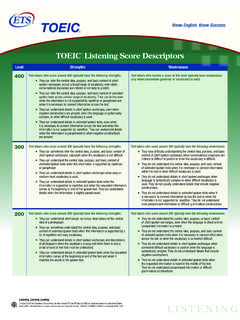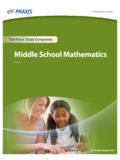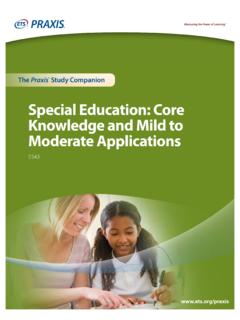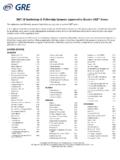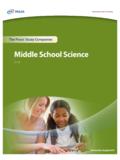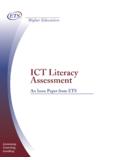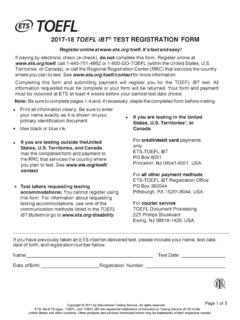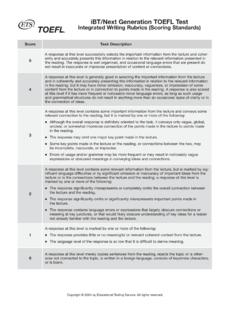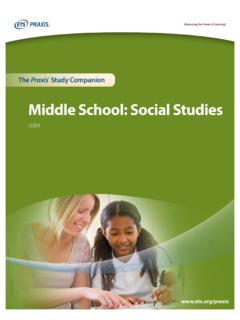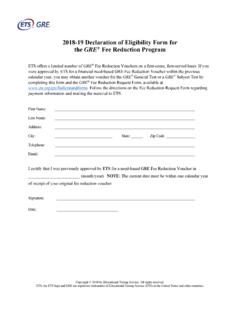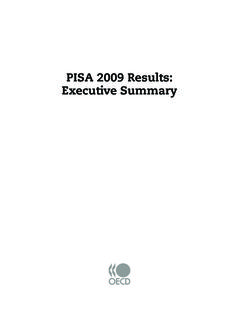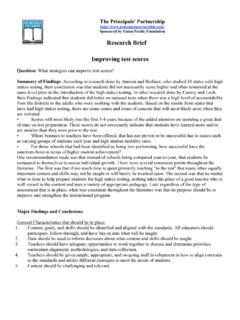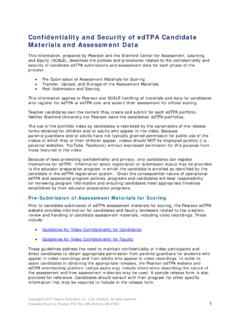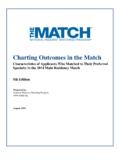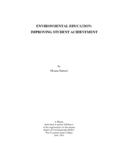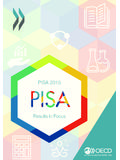Transcription of Test and score Data summary for TOEFL and Paper-based …
1 January 2010 December 2010 TesT DaTaTest and score data summary forTOEFL Internet-basedand Paper-based TestsThe TOEFL Test Quality Beyond MeasureTest and score DataThis edition of the TOEFL Test and score data summary contains data on the performance of examinees who took the TOEFL Internet-based test ( TOEFL iBT ) or the TOEFL Paper-based test ( TOEFL PBT) between January and December of English as a Foreign LanguageTm2 History of the TOEFL Program ..3 The TOEFL Internet-Based Test ( TOEFL iBT ) ..4 Internet-Based Test data for 2010 ..5 Table 1. Observed Minimum and Maximum 2. Percentile Ranks Total 3. Percentile Ranks Graduate-Level 4. Percentile Ranks Undergraduate-Level Students ..6 Table 5. Percentile Ranks Other 6.
2 Percentile Ranks Applicants for Professional 7. Means and Standard Deviations 8. Means and Standard Deviations Females ..8 Table 9. Total and Section score Means All Examinees by Native Language ..9 Table 10. Total and Section score Means Nonnative English-Speaking Examinees by Geographic Region and Native Country ..10 The TOEFL Paper-based Test ( TOEFL PBT) ..12 Paper-based Test data for 2010 ..13 Table 11. Observed Minimum and Maximum 12. Percentile Ranks Total 13. Percentile Ranks Graduate-Level 14. Percentile Ranks Undergraduate-Level Students ..15 Table 15. Percentile Ranks Other 16. Percentile Ranks Applicants for Professional 17. Means and Standard Deviations 18. Means and Standard Deviations Females ..16 Table 19. Total and Section score Means All Examinees by Native Language.
3 17 Table 20. Total and Section score Means All Examinees by Geographic Region and Native Country ..18 Table 21. Percentile Ranks for TWE Scores ..19 Table of ContentsCopyright 2011 by Educational Testing Service. All rights , the ETS logos, GRADUATE RECORD EXAMINATIONS, LISTENING. LEARNING. LEADING., TOEFL and TWE are registered trademarks of Educational Testing Service (ETS) in the United States and other countries. TOEFL IBT is a trademark of ETS. COLLEGE BOARD is a registered trademark of the College Entrance Examination Board. A single copy of this publication may be downloaded for individual use. No part of this publication may be reproduced or transmitted in any form or by any means without permission in writing from Educational Testing Service, Princeton, NJ, USA.
4 Violators will be prosecuted in accordance with all applicable copyright and trademark laws. Permission requests may be made online at or sent to Educational Testing Service, Office of the General Counsel, Attn: Permissions Administrator, Rosedale Road, MS 04C, Princeton, NJ 08541, additional information about TOEFL visit 3 History of the TOEFL ProgramThe Test of English as a Foreign Language , better known as TOEFL , is designed to measure the English-language proficiency of people whose native language is not English. TOEFL scores are accepted by more than 8,000 colleges, universities, and licensing agencies in more than 180 countries. The test is also used by governments, and scholarship and exchange programs worldwide.
5 A list of institutions and agencies that accept TOEFL scores is available on the TOEFL website at TOEFL Program A national council on the testing of English as a foreign language was formed in 1962; its members were representatives of more than 30 private organizations and government agencies concerned with the English-language proficiency of nonnative speakers of English who wished to study at colleges and universities in the United States. The council supported the development of the TOEFL test for use starting in 1963-64. Financed by grants from the Ford and Danforth Foundations, the TOEFL program was first administered by the Modern Language Association. In 1965, the College Board and Educational Testing Service (ETS ) assumed joint responsibility for the program. Because many who take the TOEFL test are potential graduate students, a cooperative arrangement for the operation of the program was entered into by ETS, the College Board, and the Graduate Record Examinations Board in 1973.
6 Under this arrangement, ETS is responsible for administering the TOEFL program with guidance from the TOEFL Board. The TOEFL Board is comprised of 16 members. Some are affiliated with such institutions and agencies as undergraduate and graduate schools, community col-leges, nonprofit educational exchange organizations, and other public and private agencies with an interest in international education. Other members are specialists in the field of English as a foreign or second of the Test The test originally contained five sections. As a result of extensive research, a three-section test was developed and introduced in 1976. In July 1995, the test item format was modified somewhat within the same three-section structure. In recent years, various constituencies called for a new TOEFL test that would (1) be more reflective of communicative compe-tence models; (2) include more constructed-response tasks and direct measures of writing and speaking; (3) include tasks that integrate the language modalities tested; and (4) provide more information than the Paper-based TOEFL test ( TOEFL PBT) about the ability of international students to use English in an academic environment.
7 Accordingly, the TOEFL Board initiated a broad effort under which language testing will evolve in the twenty-first century. The introduction of the computer-based TOEFL test ( TOEFL CBT) in 1998 was the first incremental step in this broad test-improvement effort. The next step was the introduction of an Internet-based version of the TOEFL test ( TOEFL iBT) in Sep-tember 2005. TOEFL iBT assesses all four language skills (reading, listening, speaking, and writing) that are important for effective communication. TOEFL iBT emphasizes integrated skills and provides better infor-mation to institutions about students ability to com-municate in an academic setting and their readiness for academic coursework. The test was first launched in the United States, and was gradually rolled out worldwide during 2005 and 2006.
8 As TOEFL iBT was introduced in an area, TOEFL CBT was discontinued after a period of overlap to ensure a smooth transition to TOEFL iBT. The final administration of TOEFL CBT was held in September 2006. TOEFL PBT will continue to be offered on a limited basis to support the TOEFL testing network in areas where TOEFL iBT is not available. The TOEFL Test and score data summary contains information about TOEFL iBT and TOEFL PBT test The TOEFL Internet-Based Test ( TOEFL iBT ) TOEFL iBT was intro-duced in the United States in September 2005 and was gradu-ally introduced world-wide during 2005 and 2006. TOEFL iBT was developed in response to a request by insti-tutions to provide a test that would measure nonnative speakers ability to communicate in English in an academic setting.
9 TOEFL iBT: Measures the ability to communicate by combining, or integrating, all four language skills Reading, Listening, Speaking, and Writing Is 100% academically-focused, measuring the kind of English used in academic settings Provides fair and objective scoring Provides valid and reliable information to support score users in making effective decisions regarding a person s English-language proficiencyTest takers have up to four hours to complete the test, and all four sections are taken on the same day. The Reading section measures the ability to understand aca-demic reading material, and the Listening section mea-sures the ability to understand spoken English as it is used in colleges and universities. The Speaking section consists of six tasks that measure the ability to speak in English in an academic setting.
10 The Writing section consists of two tasks that measure the ability to write in a way that is appropriate for college and university coursework. Some questions in the Speaking and Writing sections require the test takers to combine, or integrate, information from more than one source. For example, test takers are asked to read a passage, listen to a short lecture about a topic, and then speak or write in response. These integrated tasks are designed to simulate the aca-demic delivery enables ETS to deliver the test at official test centers in more locations. There are currently more than 4,500 TOEFL iBT test centers in over 165 countries, and the number continues to grow. Speaking and writing tasks receive multiple ratings to provide unbiased, objective evaluations of the responses via the ETS Online Scoring Preparation Everyone registered to take the TOEFL test receives test preparation materials free of charge.
